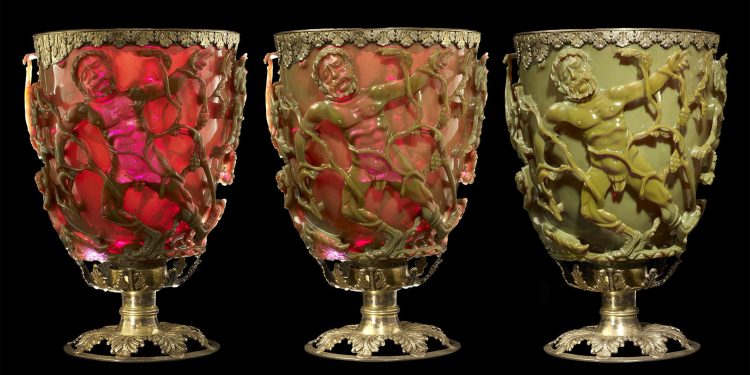This particular Roman glass artifact, the Lycurgus Cup, is not only the sole surviving example crafted from its distinct type of glass but also showcases the most striking color transformation. Regarded as the most stunning glasswork of its era, it features fittingly intricate decorations.
The Enigmatic Elegance of the Lycurgus Cup
The Lycurgus Cup, an extraordinary Roman artifact dating back to the 4th century AD, has long fascinated historians, artists, and scientists alike. This unique glass chalice boasts a captivating design, remarkable craftsmanship, and unusual optical properties that have puzzled experts for centuries. This article will delve into the five distinct characteristics of the Lycurgus Cup that make it a truly exceptional piece of art and history.
Dichroic Glass – A Visual Phenomenon of Color Change
One of the most striking features of the Lycurgus Cup is its dichroic glass composition, which causes the vessel to change colors depending on the lighting conditions. When lit from the front, the cup exhibits a serene green hue, while backlighting reveals a vibrant, fiery red. This color-changing property is attributed to the presence of tiny gold and silver nanoparticles in the glass, a discovery that has inspired modern nanotechnology applications.
The Intricate Design – A Masterful Depiction of the Lycurgus Myth
The cup’s name is derived from the detailed scene it depicts, featuring King Lycurgus of Thrace entwined in grapevines as punishment for defying Dionysus, the Greek god of wine. The mythological scene is masterfully crafted using an elaborate technique called diatretum, which involves cutting away the glass around the figures to create a stunning, three-dimensional effect. This intricate design highlights the exceptional skill and artistry of the Roman craftsmen who created the cup.
A Testament to Ancient Glassmaking Techniques – The Art of Roman Glass
The Lycurgus Cup is a prime example of the advanced glassmaking techniques practiced by the Romans. The vessel’s creation involved several complex processes, including glassblowing, carving, and polishing. The cup’s delicate design and the precise control of the glass’s color-changing properties are evidence of the remarkable expertise and knowledge of the ancient artisans.
A Rare and Valuable Artifact – The Cultural Significance of the Lycurgus Cup
The Lycurgus Cup is the only known complete example of a Roman diatretum vessel, making it an incredibly rare and valuable artifact. Its cultural significance is further amplified by its connection to the Roman Empire’s history and the mythology of the time.
The cup has been housed in various collections throughout history, including the prestigious British Museum, where it currently resides, captivating visitors with its mystical appearance and intricate design.
Modern Applications and Scientific Inspiration – The Legacy of the Lycurgus Cup
The Lycurgus Cup’s unique optical properties have garnered significant interest from scientists, particularly in the field of nanotechnology. Researchers have studied the cup’s glass composition to understand better how the ancient artisans achieved the dichroic effect. This research has led to advances in modern materials science, inspiring the development of new technologies, such as color-changing glass and advanced optical devices.
The Enduring Enchantment of the Lycurgus Cup
With its mesmerizing color-changing properties, intricate design, and testament to ancient glassmaking techniques, the Lycurgus Cup continues to captivate the imagination of historians, artists, and scientists. As we strive to unlock the secrets behind this mystical artifact, its legacy lives on, inspiring new generations of researchers and craftsmen.
The Lycurgus Cup stands as a shining example of the extraordinary skill and creativity of the Roman artisans who brought this exceptional piece of history to life. The enduring enchantment of the Lycurgus Cup ensures that its story will continue to be told and admired for years to come, as a testimony to the brilliance of ancient craftsmanship and the ever-evolving quest for knowledge.
Learn more about it:
PLEASE READ: Have something to add? Visit Curiosmos on Facebook. Join the discussion in our mobile Telegram group. Also, follow us on Google News. Interesting in history, mysteries, and more? Visit Ancient Library’s Telegram group and become part of an exclusive group.











